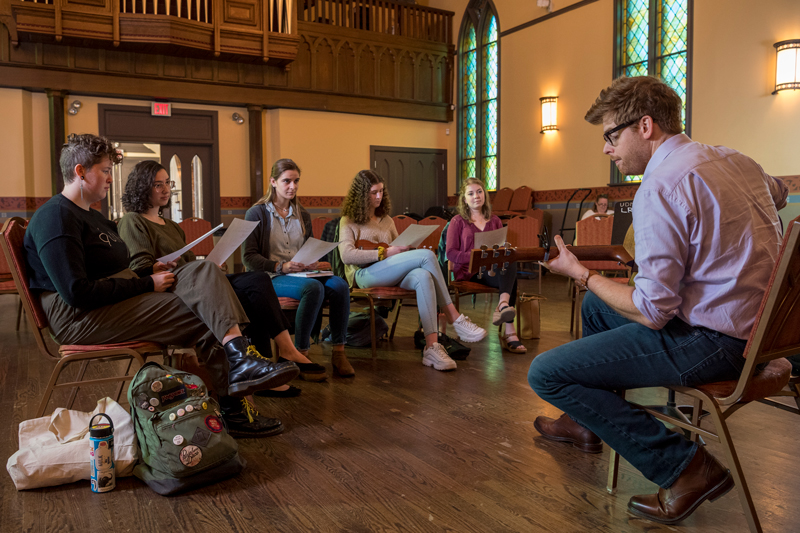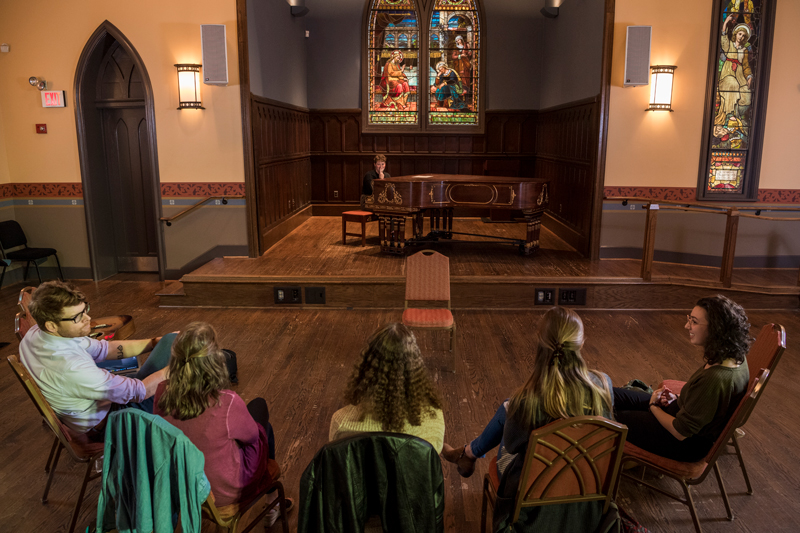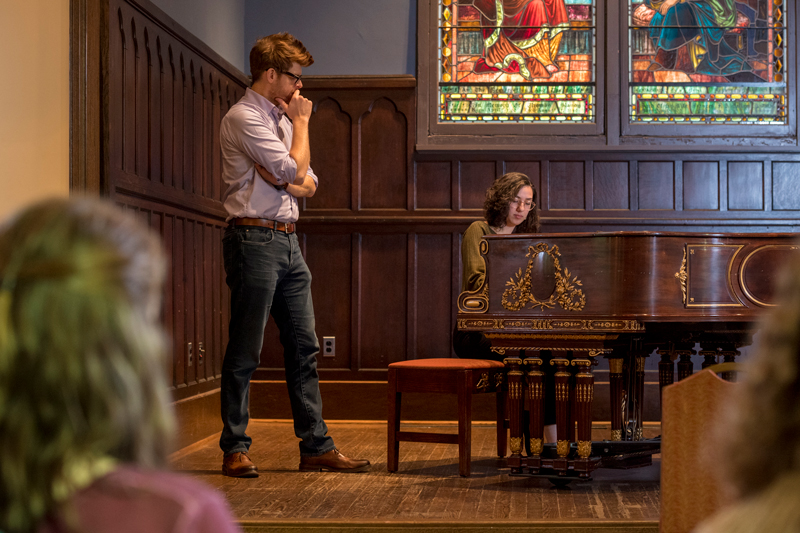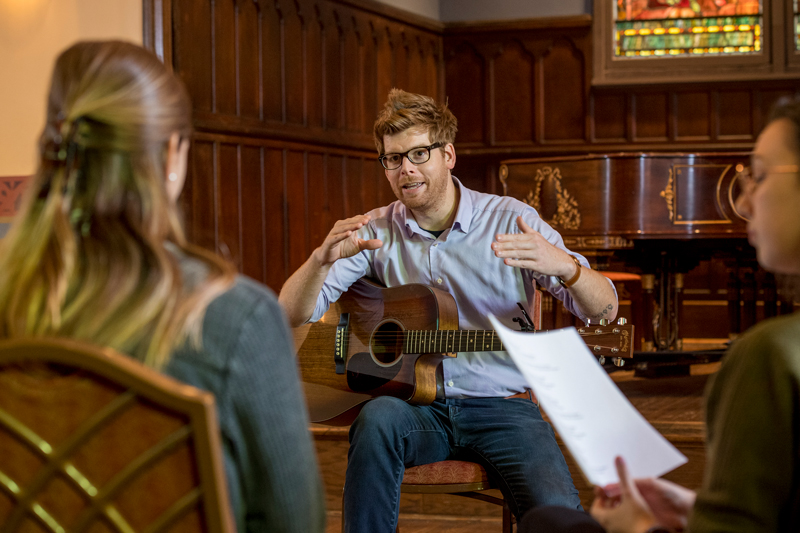


Creating music, connections
Photos by Kathy F. Atkinson October 21, 2019
Songwriting class offers students an enriching experience
“Tell me about yourself” can be a daunting request. What parts of your life do you choose to talk about?
We’re told to perfect an elevator pitch — a 30-second speech explaining who we are and what we do. But what if, instead of speech, you selected a piece of music that expresses who you are?
And what if you could actually write that song yourself — the words and music of your own life?
“We’re all experts in ourselves,” says Mark Adams, assistant professor of instrumental music education at the University of Delaware. This, he said, is what makes songwriting such a personal and emotional experience, as well as a musically enriching process.
Last spring, Adams introduced Songwriting Seminar (MUED367), an experimental course offered to students majoring in music education, most of whom will go on to teach music anywhere from pre-K through high school.
The course has attracted attention not only from UD students but also from other music educators, who have invited Adams to present a series of talks about it at a national conference in November.

The seminar explored how the deeply personal experience of songwriting connects to the formal musical education and development music education majors experience at UD.
The 12 students in the seminar started the semester by musically introducing themselves to each other.
They came to class on Day One having already completed the first assignment — select a song they knew and explain why it resonates with them, or present an original piece. Some played piano or guitar, while others sang something they’d written themselves.
“We got to know everyone’s individual style,” said senior Sophia DiLeo. “Jazz, folk, pop. It set the tone that first day that it was a safe space to express ourselves.”
With 128 required credit hours in the four-year program, music education majors take the same classes, end up knowing each other well and make a lot of music together — but not in this way.
“I liked writing songs a lot when I was younger,” DiLeo said, “but I had never performed one of my original songs at UD.”
Adams modeled the class on a songwriting circle, where small groups meet regularly to share their work and receive feedback. There were different types of assignments — such as taking an existing song and writing original lyrics, or the opposite, writing new music for existing text, or working in groups to write a song together — but the structure was the same for each class period: performance followed by discussion.

At the beginning, Adams guided the feedback, but as the semester progressed, the students started recognizing each other’s style and targeting their feedback. Comments focused not on what would make a better song, but on what might make a better song for a particular person based on their style.
“For me, feedback was the most important part of the class,” DiLeo said. “It’s hard to judge another person’s creativity.”
Learning how to give targeted feedback to others was just as beneficial as hearing it about their own work, the students said. The process “increased my awareness and discernment,” said junior Emily Fareed. “We learn about form and structure in other classes, but I listen to all music differently now and can hear what’s happening structurally.”
According to Adams, a class like this has the potential to resonate with students who might not identify with the traditional, Western music that is a staple of classical music programs at UD and elsewhere.
Also, he said, “It’s about showing our MuEd students a different kind of classroom experience,” first in their role as students and later as music teachers sharing what they’ve learned with their own students.
“This opened doors for me, not just the confidence to share my own art, but techniques to use in exposing my future students to musical collaboration and the creative process,” Fareed said.
Adams came to UD in the fall of 2017. As word got around that he was a singer/songwriter himself, students began coming to him with questions and to chat about their own songwriting experiences.
He said he soon realized that there was a pocket of students at UD who were already creating their own music, writing not for a class assignment, but creating for their own personal reasons.
Music majors learn technical music skills in aural skills, harmony, sight-reading and pedagogy classes, but Adams sought to give students a different kind of music-making experience focused on a sense of community and understanding, more like a workshop setting than a traditional classroom.
Despite the busy coursework music students already have, the department embraced this experimental course as a way to expand students’ experiences, and for good reason.
In 2014, the National Coalition for Core Arts Standards, an alliance of national arts and arts education organizations, published the first revision of national arts standards in 20 years for dance, media arts, music, theatre and visual arts education. These standards include four anchors of education: creativity, performing, responding and connecting.

Aimee Pearsall, instructor in music education at UD, explained that the traditional musical education curriculum has always had a strong emphasis on performing, connecting and responding, but in recent years music educators have been working to include more creativity in their classrooms.
“As the field of music education continues to progress, UD’s music education faculty seeks to provide experiences that our own students can take into their future classrooms,” she said. “Songwriting is an exemplar of music creativity. It fosters a high level of musical engagement and facilitates the highest level of musical thinking.
“Music educators want to infuse more creative opportunities into our schools, so we need to provide our music education majors with these creative learning opportunities.”
The National Association for Music Education also recognizes songwriting as a valuable addition to the curriculum. The organization has asked Adams to present a series of talks at its 2019 national conference in November, focusing on the classroom community created through songwriting as well as methods of songwriting and even lesson planning for a songwriting class.
Through the course, Adams said he watched the students grow from being nervous at this new experience to being empowered in their own musicianship and telling their own stories. Because this music felt more personal to each student, it didn’t feel like work.
“Having a creative, emotive outlet actually helps fuel the workload students have in their other classes,” Adams said.
Listen to some original student music
Adams’ final assignment took the students outside the safe space of their songwriting community by asking them to record and post EPs of the work they created. Several class members have shared their work here:
Contact Us
Have a UDaily story idea?
Contact us at ocm@udel.edu
Members of the press
Contact us at 302-831-NEWS or visit the Media Relations website

